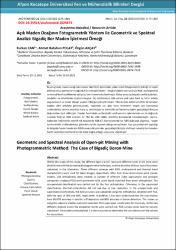Açık maden ocağının fotogrametrik yöntem ile geometrik ve spektral analizi: Bigadiç Bor Maden İşletmesi örneği
Künye
Can, F. , Polat, A. B. & Akçay, Ö. (2022). Açık Maden Ocağının Fotogrametrik Yöntem ile Geometrik ve Spektral Analizi: Bigadiç Bor Maden İşletmesi Örneği . Afyon Kocatepe Üniversitesi Fen Ve Mühendislik Bilimleri Dergisi , 22 (1) , 175-186 . DOI: 10.35414/akufemubid.1029873Özet
Bu çalışmada, maden ocağında mevcut olan farklı katmanlar, yakın resim fotogrametrisi tekniği ile tespit
edilmiş ve bu katmanların yoğunlukları hesaplanmıştır. Fotoğraf çekimi için sırasıyla RGB, multispektral
ve termal bant özelliklerine sahip üç farklı kamera kullanılmıştır. Daha sonra üç boyutlu nokta bulutları,
modeller ve ortofotolar oluşturulmuştur. Üç ortofotodan elde edilen yedi adet bant ile farklı indeks
uygulamaları ve temel bileşen analizi (TBA) gerçekleştirilmiştir. TBA ile elde edilen ortofoto ile beraber
toplam dört ortofoto görüntüsünde, madende yer alan farklı birimlerin tespiti için kontrolsüz
sınıflandırma, termal ortofoto hariç üç ortofotoda ise kontrollü sınıflandırma işlemi gerçekleştirilmiş ve
doğrulukları test edilmiştir. Yapılan kontrolsüz ve kontrollü sınıflandırma işlemlerinde en iyi doğruluk
sırasıyla %60 ve %80 oranları ile TBA ile elde edilen ortofoto kullanılarak hesaplanmıştır. Ayrıca,
kullanılan indekslerin zeolitik tüf tespitinde %86.67, bor tespitinde ise %80 doğruluk oluşması, tespit
için kontrollü sınıflandırmaya göre daha iyi bir seçenek olduğu anlaşılmıştır. Kazı çalışmalarının yapıldığı
iki bölgede hacim hesabı için RGB kamera ile çekimler gerçekleştirilmiştir. Hafriyat hakedişi için hesabın
hacim üzerinden belirlenmesinin daha doğru olduğu sonucuna ulaşılmıştır. Within the scope of this study, the different layers which represent different rocks in the mine were
determined with the terrestrial photogrammetry technique, and the densities of these layers have been
calculated in the laboratory. Three different cameras with RGB, multispectral and thermal band
characteristics were used for taken images, respectively. After that, three-dimensional point clouds,
models, and orthophotos were created. A number of different index applications and principal
component analysis (PCA) were performed with seven bands obtained from three orthophotos. The
unsupervised classification was carried out for the four orthophotos. Otherwise, in the supervised
classification, thermal orthophotos did not use due to low resolution. In the unsupervised and
supervised classifications, the best accuracy was calculated using the orthophotos obtained with PCA,
with the rates of 60% and 80%, respectively. In addition, it has been understood that the used indices
have 86.67% accuracy in zeolitic tuff detection and 80% accuracy in boron detection. This shows us
using the indices is a better option for detection than supervised classification for this study. At the two
different stations where the excavation works were carried out, RGB camera shots took for volume
calculation. It has been concluded that it is more accurate to determine the calculation over the volume
for excavation.
Kaynak
Afyon Kocatepe Üniversitesi Fen ve Mühendislik Bilimleri DergisiCilt
22Sayı
1Bağlantı
https://doi.org/10.35414/akufemubid.1029873https://dergipark.org.tr/tr/download/article-file/2104801
https://hdl.handle.net/11630/11148
Koleksiyonlar
- Cilt 22 : Sayı 1 [26]



















